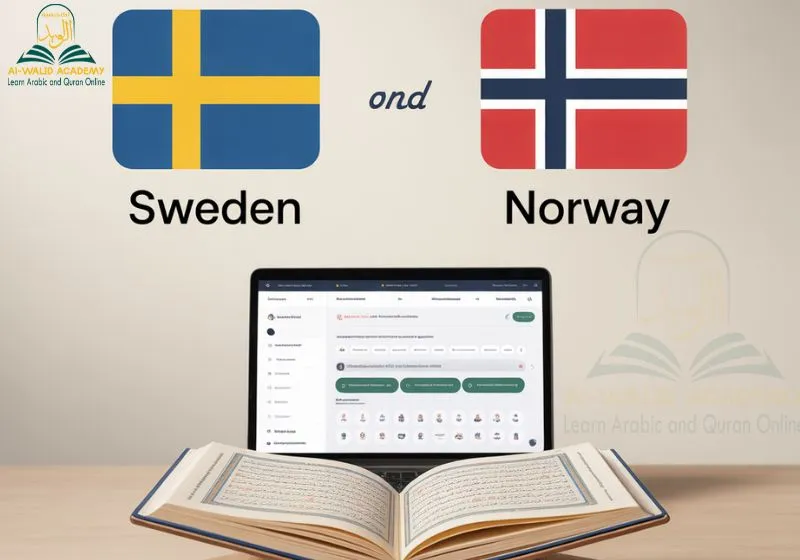If you want your child to memorize the Quran in a fun and easy way, Al Walid Academy offers The Best Online Hifz Program for Children that turns memorization into an enjoyable experience. With skilled teachers and a simple approach, every child gains confidence and gets closer to completing the Holy Quran.
The Best Online Hifz Program for Children
If you’re looking for a program that helps your child love and memorize the Quran with joy, Al Walid Academy proudly offers The Best Online Hifz Program for Children.
This program is carefully designed to make memorization simple, interactive, and stress-free.
With patient, qualified teachers who motivate kids through fun rewards and gentle guidance, every child learns the Quran step by step—loving the journey, not fearing it.
All our Quran Courses Online are designed to make Quran learning accessible, flexible, and enjoyable for every family.
What sets a truly exceptional Hifz program apart?
When choosing a Quran memorization course for your child, the main question is: what makes a program truly exceptional, not just “another online class”?
It’s not only about memorizing words — it’s about understanding, mastering, and staying consistent. Here’s what defines an outstanding Hifz program:
- A clear and organized plan: A daily memorization schedule and weekly review plan keep your child progressing steadily without confusion.
- Experienced and patient teachers: The teacher plays the biggest role — they must know how to deal with children kindly, keeping each session productive and enjoyable.
- Regular parent updates: A great program provides weekly or monthly reports that help parents track progress and focus areas.
- Flexible scheduling: Families have different routines; flexible timing helps make Quran learning fit smoothly into your child’s day.
- Focus on tajweed and pronunciation: Memorization without correct recitation is incomplete. Strong programs teach both side by side.
- Fun, engaging environment: Games, competitions, and interactive sessions keep children excited and motivated to keep learning.
- Certificates and rewards: Every achievement — no matter how small — deserves recognition. A simple certificate or kind word builds lasting motivation.
Through our Quran Classes for Adults, parents can join their children on the same spiritual journey of learning and memorization.
How to identify a trusted online Quran platform for kids
Before enrolling your child in an online Hifz course, make sure the platform you choose is trustworthy. Here’s a list help you choose right:
- Check reviews and testimonials – Read what other parents say; real experiences show the platform’s true quality.
- Ask about teacher qualifications – Make sure instructors hold Ijazah or Quran-teaching certificates and have experience with kids.
- Try a Free Trial Class – A trial is the best way to test the teacher’s patience, style, and how your child interacts during lessons.
- Request a written plan – A professional platform always provides a clear weekly or monthly plan for memorization and review.
- Confirm privacy and safety policies – Especially for online classes, ensure lessons are monitored and your child’s information is protected.
- Check communication channels – There should be an easy way to reach the teacher or admin if you need support.
- Ask about results – Look for platforms with real success stories and students who have completed their Hifz.
Learn more about: Best Online Quran Classes in USA
Why Online Hifz Programs Are Transforming Quran Learning
In today’s fast-paced world, families are turning more toward online Hifz programs — not just because they’re convenient, but because they’re changing how kids connect with the Quran.
These programs combine deep Islamic values with flexible, child-friendly learning styles that fit any schedule or lifestyle.
Our Quran Memorization Course helps kids build a strong and confident connection with the Quran from an early age.
Accessibility and Flexibility for Families Worldwide
One of the biggest reasons online Hifz programs for children are becoming so popular is accessibility.
No matter where your family lives — in the U.S., the U.K., or anywhere else — your child can memorize the Quran from home with qualified tutors. Parents don’t need to worry about driving long distances or fixed class times; kids can learn at their own pace, whenever it fits best.
This flexibility also means your child won’t feel overwhelmed. With customized schedules and one-on-one sessions, children stay consistent and motivated while enjoying their memorization journey.
The Quran Lessons for Kids Online at Al Walid Academy make memorization fun, engaging, and perfectly structured for young learners.
Combining Islamic Tradition with Modern Learning Tools
What makes the best online Hifz programs for children truly special is how they blend the beauty of traditional Quranic learning with modern technology.
Interactive digital whiteboards, engaging visual lessons, and real-time teacher feedback make memorization more exciting and effective.
At the same time, these platforms keep the spiritual essence of Hifz intact — focusing on Tajweed, understanding meanings, and building love for the Quran in young hearts.
This perfect mix of old and new helps children connect deeply with the Quran, not just memorize it.

Key Features of a Successful Hifz Program for Kids
If you want your child to memorize the Quran with love and consistency, you need to choose The Best Online Hifz Program for Children — one that truly understands how kids think and keeps them motivated every step of the way.
A successful Hifz program isn’t just about memorization; it’s about creating a full learning experience that helps kids enjoy their journey and grow steadily in their connection with the Quran.
The Tajweed Course ensures every child learns to pronounce each verse exactly as it should be.
Certified Quran Teachers with Child-Friendly Methods
The teacher is the heart of any online Hifz program for kids. A great tutor doesn’t only know the Quran well — they also know how to connect with children, teach gently, and inspire love for learning.
Certified Quran teachers use fun, easy-to-follow techniques that encourage kids rather than pressure them.
They also focus on Tajweed and proper pronunciation from the start, so children learn to recite the Quran correctly and confidently.
Learn more about: Best Age for Learning Quran Online
Interactive Memorization Exercises and Digital Tools
Kids love to explore and interact — and that’s exactly what modern online Hifz programs for children make use of.
They include engaging digital tools that let kids listen to themselves and correct mistakes easily like
- Interactive whiteboards
- Learning apps
- Voice playback exercises
These interactive lessons turn memorization into a joyful experience instead of simple repetition. The child becomes more engaged and motivated to continue learning every day.
In the Quranic Arabic Course, kids explore the original language of the Quran to understand it deeply.
Consistent Revision System and Weekly Evaluations
Regular revision is the secret to strong memorization. That’s why top online Hifz programs for kids use a structured weekly review system to help children stay on track.
Each week includes a simple evaluation that shows the child’s progress and builds a sense of accomplishment. This consistency strengthens memory, boosts confidence, and keeps the child excited to keep learning.
In short, the success of any Quran memorization program for kids depends on three essential pillars:
- A skilled and caring teacher
- Interactive learning toolS
- A consistent review system.
When these three elements come together, children don’t just memorize the Quran — they fall in love with it.
How to Keep Kids Motivated During Hifz Classes

Every parent dreams of seeing their child memorizing the Qur’an with love and dedication — but keeping kids motivated isn’t always easy. It’s natural for children to lose focus, especially if memorization feels like a routine task.
That’s why choosing The Best Online Hifz Program for Children means finding one that makes learning fun, meaningful, and full of encouragement.
The real magic happens when Hifz becomes an enjoyable journey — filled with interaction, stories, and positive energy.
The Modern Standard Arabic program strengthens reading and writing skills alongside Quran memorization.
Gamified Learning, Rewards, and Positive Reinforcement
Kids love games and competition — so why not use that to help them learn the Qur’an? Modern online Hifz programs for kids now apply gamified learning methods, turning memorization into an exciting adventure with levels, badges, and small rewards.
For example, a child might earn the title “Hafiz of the Week” or collect points to unlock fun prizes.
These small wins create a sense of excitement and accomplishment that keeps them eager to learn more.
But what truly makes a difference is positive reinforcement. Teachers and parents should always motivate rather than pressure — celebrating effort, not just results.
A kind word, a simple clap, or a warm smile can do wonders for a child’s confidence and love for memorizing the Qur’an.
Discover How to Understand the Quran Word by Word and feel every verse deeply.
Building a Love for the Qur’an Through Stories and Meaning
Children connect best when they understand what they’re learning, not just repeat words.
That’s why top online Hifz programs for children focus on explaining the meanings and stories behind verses.
Before memorizing a new surah, the teacher might tell a short story about its background or message, helping the child relate the words to real-life lessons.
Some platforms even use visuals, animations, and short videos
to explain Qur’anic concepts in a simple, age-appropriate way.
When kids understand the message behind the verses, they memorize with both their hearts and minds — and that’s what makes the learning last.
Thus, the secret behind The Best Online Hifz Program for Children lies in combining fun, encouragement, and understanding.
When kids feel happy, supported, and inspired by the words they’re learning, Hifz turns from a task into a joyful journey — one that plants the Qur’an deeply in their hearts, not just on their tongues.
Read about: Summer Quran Classes for Kids
Learn Quran, Arabic, and Islamic Studies with certified teachers in fun, interactive, and personalized sessions. Join thousands of students around the world and begin your path today!
Book Your Free Trial Session Contact UsThe Importance of Parental Role in Online Hifz Success
A child’s success in memorizing the Qur’an doesn’t come from the program alone — it starts at home, with parents who encourage and support every step of the journey.
Even with The Best Online Hifz Program for Children, parental involvement makes all the difference.
When kids feel that their parents care about their progress, they stay motivated and proud of what they’re doing.
Simply put — the teacher plants the knowledge, but parents plant the love that makes the Qur’an stay in the heart.
Learn with the Best Online Quran Teacher and Tutors who guide you every step of the way.
Easy Tracking Dashboards and Progress Reports
Modern online Hifz programs for kids make it easier than ever for parents to stay involved.
Through smart tracking dashboards, parents can see everything in one place — which surahs their child has memorized, attendance, weekly progress, and overall performance.
Everything is displayed clearly and accessibly on the platform,
so parents can stay updated without having to constantly ask the teacher for updates.
Many platforms also send weekly progress reports with teacher feedback and personalized suggestions to help parents guide their children more effectively.
This level of transparency helps families play an active role in the memorization process and understand exactly how to keep their child on track and motivated.
How Parents Can Support Memorization Without Knowing Arabic
Parents don’t need to know Arabic to support their child’s Qur’an memorization journey.
What matters most isn’t language — it’s encouragement, consistency, and emotional support.
When children feel proud because their parents are proud,
that emotional connection becomes a powerful motivator to continue learning.
Here are some simple ways parents can help:
- Set a fixed time each day for memorization and review.
- Listen to what your child has memorized, even if you don’t understand the meaning.
- Praise every small achievement with kind words or a small reward.
- Communicate with the teacher regularly to address any challenges together.
Creating this warm and encouraging environment at home helps the child see the Qur’an not as a subject to study, but as a beautiful act of worship that brings them closer to their parents and to Allah.
In short, The Best Online Hifz Program for Children becomes truly effective when parents are part of the journey.
The teacher guides, the platform organizes, but it’s the parents’ presence and love that make memorization last — turning every session into a heartfelt experience that stays with the child for life.
Online Hifz Program vs. Traditional Madrasa — Which Is Better?
When parents decide to start their child’s Quran memorization journey, the first question that comes up is — should I choose a traditional madrasa, or go with an Online Hifz Program for Kids?
The truth is, there’s no one-size-fits-all answer — it depends on your family’s routine and comfort.
But one thing’s for sure: online learning has completely changed the game, making Quran memorization easier, more flexible, and perfectly suited for today’s families.
An online Hifz program isn’t just a Zoom class — it’s a structured system that helps children memorize the Qur’an in a comfortable home environment, while teachers guide and track their progress every step of the way.
Read about: Overcoming Challenges in Quran Memorization
A Comparison Between Online Hifz Programs and Traditional Madrasas
Many parents wonder whether enrolling their children in an online Hifz program or a traditional madrasa is the better choice.
The table below gives you a clear comparison to help you decide what works best for your child and your family’s routine.
| Aspect | Online Hifz Program | Traditional Madrasa |
| Schedule Flexibility | You can choose class times that fit your child’s daily routine | Fixed schedules that are hard to change |
| Learning Environment | Comfortable and safe at home | Sometimes crowded or less comfortable |
| Teaching Style | Interactive and engaging with games and stories | Focuses mainly on memorization and repetition |
| Parental Involvement | Easy to follow progress and support your child online | Limited involvement, usually through reports |
| Teacher Quality | Varies depending on school and teacher | Varies depending on school and teacher |
| Tajweed Learning | Taught gradually in a simple, practical way | Often a separate subject taught later |
| Motivation Methods | Digital rewards and continuous encouragement | Depends on the teacher’s personal approach |
| Final Results | Children memorize confidently and enjoy the process | Faster memorization but sometimes less focused |
Time Flexibility and Learning Pace
One of the biggest advantages of Online Hifz Programs is flexibility.
Unlike traditional madrasas with strict schedules, online classes allow families to choose what works best for their lifestyle.
If your child focuses better in the evening or after school — no problem at all.
Each child learns at their own pace. Fast learners can move ahead quickly, while others can take their time without feeling pressured.
This makes the memorization process enjoyable instead of stressful.
The goal isn’t just to memorize — it’s to build a deep love for the Qur’an.
Certified Teachers vs. Local Availability
In traditional madrasas, parents usually have to pick from the few local teachers available — which can limit quality and teaching styles.
But with Online Hifz Programs for Kids, parents have global access to certified Quran teachers who specialize in teaching children with patience and fun methods.
Many platforms even let parents view teacher profiles, reviews, and qualifications before enrolling their child.And if a child isn’t connecting with a specific teacher, it’s easy to switch — no awkward conversations, no pressure.
This flexibility ensures that every child learns comfortably, with the right teacher guiding them throughout their Hifz journey.
Should Kids Learn Tajweed Before Memorization?

One of the most common questions parents ask when starting their child’s Quran journey is: Should my child learn Tajweed first, or start memorizing and focus on pronunciation later?
The truth is, there’s no single answer for everyone — but what’s clear is that Tajweed isn’t separate from memorization.
It’s the foundation that helps children recite correctly from the very beginning.
If a child starts memorizing with pronunciation mistakes, those mistakes often stick — and become harder to fix later.
That’s why The Best Online Hifz Program for Children takes a balanced approach: teaching Tajweed naturally during memorization.
Children learn the correct sounds, rhythm, and rules without feeling pressured or overwhelmed by complex lessons.
Why Tajweed Is Essential for Correct Hifz
Tajweed is the key that allows children to recite the Qur’an exactly as it was revealed — beautifully, accurately, and with meaning.
It’s not just about perfecting the sound; it’s about understanding how pronunciation affects the words and their message.
When kids learn Tajweed early on, they develop a deeper connection to what they recite. They become more confident, focused, and motivated to improve.
It also helps them recognize mistakes quickly and correct themselves — a skill that builds independence and lasting accuracy.
That’s why every successful Online Hifz Program for Kids includes Tajweed lessons in a simple, age-appropriate way.
No heavy theory — just practical, engaging learning that fits right into their memorization routine.
Integrating Tajweed Naturally into the Memorization Journey
The best way for children to learn Tajweed is not through long grammar-style lectures or memorizing rules — but by applying those rules while they memorize the Qur’an itself.
For example, when the teacher listens to a child recite, they correct pronunciation or elongation on the spot.
This real-time feedback helps the child learn naturally and see proper recitation as a normal part of Hifz — not a separate subject.
Modern online Hifz platforms now use smart, engaging tools to make this process fun that train children’s ears to recognize the correct sound automatically like:
- Interactive audio clips
- Pronunciation games
- Digital exercises
Certified teachers in The Best Online Hifz Program for Children
also use advanced features like real-time correction,
personalized voice sessions, and positive reinforcement —
so kids learn Tajweed with joy, not pressure
Essential Checklist Before Enrolling in an Online Hifz Program
Before signing your child up for an online Quran memorization program, it’s important to remember that not all platforms are the same.
Choosing the right one can make a big difference in your child’s learning experience and spiritual growth. Here’s what you need to check carefully before enrolling.
- Safety, Privacy, and Accreditation
The first thing to look for is safety. Make sure the online platform provides a secure environment where only verified teachers and students can access the classes.
Check if the program has clear privacy policies that protect your child’s personal data and recorded sessions.
Accreditation is another key factor. The program should be backed by a trusted Islamic institute or educational organization.
Also, confirm that the teachers hold valid ijazah (certification) in Quran recitation or memorization. This ensures that your child is learning from qualified and reliable instructors.
- Class Size, Teacher Quality, and Learning Outcomes
The number of students per class can significantly impact your child’s progress. Smaller class sizes or one-on-one lessons allow teachers to give each student more personal attention and accurate correction during memorization.
Teacher quality is equally important. Experienced Quran teachers know how to engage kids, motivate them, and make memorization enjoyable. Look for programs that combine strong teaching skills with patience and a friendly learning atmosphere.
Finally, review how the academy tracks and reports student progress. Reliable programs often provide regular assessments or progress reports so you can see exactly how your child is improving.
Why Al Walid Academy Truly Deserves the Title “The Best Online Hifz Program for Children”
If you want your child to memorize the Quran with ease and joy, while learning in a nurturing Islamic environment, Al Walid Academy is the perfect choice.
Here, memorization isn’t just repetition — it’s an engaging journey that helps every child grow in faith, confidence, and love for the Quran.
What Makes Al Walid Academy Stand Out:
- Qualified male and female teachers who understand how to engage and motivate kids.
- Regular progress tracking that keeps parents informed and reassured.
- Interactive lessons and fun Quran games that make every session exciting.
- Flexible schedules that easily fit into your family’s daily routine.
- Tajweed naturally integrated into memorization, helping kids pronounce every word correctly from day one.
Start your child’s Hifz journey today!
Enroll in Al Walid Academy and let your child experience Quran memorization in a supportive, loving, and joyful atmosphere.
Learn Quran, Arabic, and Islamic Studies with certified teachers in fun, interactive, and personalized sessions. Join thousands of students around the world and begin your path today!
FAQs
How can I make my child enjoy Quran memorization online?
The secret is to make learning fun! Let your child feel like the class is a game, not a task. Choose a teacher who speaks gently and motivates them with kind words. When kids enjoy the session, memorization becomes so much easier.
What if my kid gets bored during online Hifz lessons?
That’s totally normal! Just switch things up — let them listen to a reciter they like, or join them while they revise. The key is not to make Hifz feel like pressure. A short break can help them come back focused and happy.
Is it okay if my child memorizes slowly?
Absolutely! The goal isn’t speed — it’s stability. If your child memorizes slowly but remembers well, that’s way better than rushing and forgetting later.
How do I know if the teacher is the right fit for my child?
You’ll notice it after a few lessons! If your child looks forward to class and interacts well, that’s a great sign. But if they seem disconnected or uninterested, try another teacher whose style fits your child’s personality better.
Can online Hifz classes help improve my child’s Arabic too?
Yes, definitely! Especially when the teacher explains the meanings of the verses while memorizing. That way, your child learns Tajweed, understands meanings, and improves Arabic pronunciation all at once.
What’s the best time of day for kids to memorize Quran?
Morning time is the best! When their mind is fresh, even half an hour of focused memorization makes a big difference — it sticks better than hours later in the day.
How can parents stay involved without interrupting the lesson?
Follow up after the class, not during it. Ask your child to summarize what they learned or recite a small part for you. This keeps you involved and supportive without adding pressure or distraction during the session.





